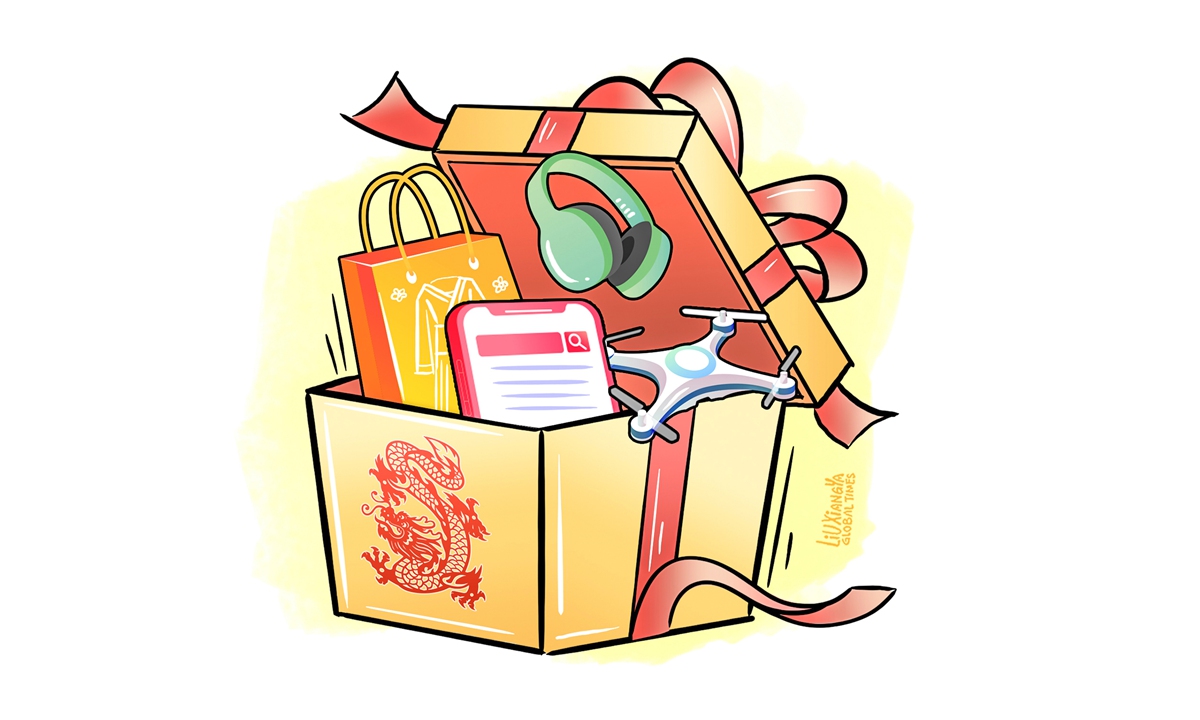
Illustration: Liu Xiangya
Chinese New Year in 2024, or the Spring Festival, was the first festival listed as an official UN floating holiday. All over the globe, about one-fifth of the world's population enjoyed a festive atmosphere and appreciated Chinese culture. During this traditional festival, the consumer market presented new trends and forms, indicating the direction of its progress.
The first major trend is the strong growth momentum of the online retail market. Online retail sales during the 2024 Online Chinese New Year's Shopping Festival, which started on January 18, have reached nearly 800 billion yuan ($112.4 billion), an increase of nearly 9 percent compared to that of the 2023 period. The sales of green products and services such as sugar-free pastries and energy-saving appliances have been growing rapidly as people are paying increasing attention to their health and the environment.
Second, the significance of the Spring Festival is more diversified. The holiday has come to signify different things to people from different areas or across different generations. Some long for a happy reunion without others paying much attention to their personal affairs, so they may choose to stay at hotels, while others hope to partake in as many activities as possible. The 2024 Spring Festival holiday was one day longer than usual, so heading home and then heading out to travel became a popular choice to celebrate the Chinese New Year.
Some people went north to enjoy ice and snow, some flew south to seek warmth and island vacations, while others headed to small towns or went overseas in pursuit of more unique experiences. As consumption concepts have evolved, catering businesses have launched special services such as takeout reunion meals and personal chef services to meet the needs of various demographics. Movie fans have also enjoyed a cinematic feast. According to the film tracking site Dengta, the total box office, including pre-sales, for the Spring Festival film season, which started on February 10, surpassed the 8 billion yuan mark on Saturday. The strong driving force of consumption can clearly be seen in every micro-life scenario.
Third, consumers favored goods and services that reflect the characteristics of traditional Chinese culture. China-Chic clothing and traditional handicrafts were hot items. For example, wearing Hanfu (the traditional clothing of the Han ethnic group) to celebrate the Chinese New Year was a major trend. The February search volume for "New Chinese Style" and "Song Brocade" on one e-commerce platform has increased by 683 percent and 2,058 percent respectively since January.
As a rising major consumer demographic, the Post-1990 and Post-2000 generations have greater identification and confidence in national culture and show a preference for "China-Chic" commodities, which empower them spiritually. They want to buy "China-Chic" festival goods such as Chinese New Year's clothes, gift boxes, or accessories, further triggering a new wave of "China-Chic" consumption.
People flock to Chinese New Year concerts and traditional cultural tourism festivals highlighted by intangible cultural heritage and museums holding Chinese dragon exhibitions. More than 100 museums in Beijing held dedicated Chinese New Year exhibitions. By exploring the value of multiple cultural heritage items and creating more symbols and products that carry Chinese tradition and spirit, museums and other organizations have turned to culture to enrich the atmosphere of this Spring Festival.
Fourth, technology and smart products remain another spotlight. The rapid development of technology is profoundly changing the way people live, and Spring Festival consumption is no exception. The sales of smart appliances showed explosive growth during the Spring Festival. From the start of the New Year Shopping Festival on January 5 to February 4, online retailer suning's smart home appliance sales increased by over 127 percent and trade-in volume exceeded 195 percent year-on-year. Consumers can easily control their home environment through smart devices such as speakers and lights. Additionally, wearable devices, drones, and other smart products became new favorites during the Spring Festival, adding a more technological feel and fun to holiday life.
The new trends and formats seen in the Spring Festival consumer market reflect the improvement in people's living standards, the changes in lifestyles and consumption concepts, and the steady progress of supply-side structural reform and high-quality economic and social development. The recent Central Economic Work Conference pointed out the advantages of "cultivating and strengthening new types of consumption, vigorously developing digital consumption, green consumption, and healthy consumption." Adapting to development trends, enriching market supply, innovating consumption scenarios, and stimulating consumption potential will help meet people's aspirations for a better life and make the engine of high-quality development more robust and more vibrant.
The author is a faculty member with the School of Applied Economics, Renmin University of China.




